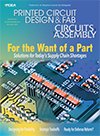Features Articles
 Lessons from a chaotic EMS warehouse.
Lessons from a chaotic EMS warehouse.
Many years ago, after punching out of a negative-culture electronics manufacturing services company, I interviewed with a smaller, family-run EMS. After numerous phone interviews, I flew to their facility and met with the president and the newly hired COO. After spending some time addressing a Q-and-A session in the president’s office, we took a facility tour, starting in the warehouse.
We never made it to the SMT lines before things went off the rails. What happened?
 Riding out tariff turmoil takes more than watching the balance sheet.
Riding out tariff turmoil takes more than watching the balance sheet.
I took a few economics courses in college, but I’m no Adam Smith. And I have predicted the future reasonably accurately, but no one would mistake me for a prophet. What I do understand, however, after nearly 50 years in manufacturing, most spent as a corporate president, is the impact of costs on profitability. More specifically, the impact of dramatic and unpredictable rising costs on a business’s ability to thrive, survive or founder.
Cost accountants typically separate expenses into two overall buckets: fixed costs and variable costs. Fixed costs may include items such as insurance, occupancy, benefits and so on. Variable costs include materials, supplies, labor, etc. Within a couple of years in manufacturing, however, I realized that in the real world only a small portion of costs are fixed, and the majority are truly variable. While all costs must be watched, monitored and managed, variable costs are the ones that make or break a balance sheet and income statement.
 Navigating change in tech isn’t just about tools.
Navigating change in tech isn’t just about tools.
Research & development drives new technology, and new technology development fuels the lifeblood of technology, industrial and consumer companies. Without product development there is no “new!” As an essential technology industry, electronics showcases how amazing, productive and cost-effective new technologies get developed, refined and launched so all industries can leverage and integrate these advancements into their versions of “new.”
For decades, companies have honed the R&D and product development process to be incredibly quick, robust and cost-effective. They have achieved this via globalization, allowing them to leverage their global footprint and specific expertise to react quickly to changing market needs or expedite the timeline for entirely new technologies. Teams collaborate among facilities in North America, Asia and Europe, creating a common and highly successful approach that companies use across various end-products and markets.
 It might be time for a 50-year-old concept to catch on in PCB fabrication.
It might be time for a 50-year-old concept to catch on in PCB fabrication.
Back in 1978, at the first Printed Circuit World Convention in London, the proceedings described a novel additive technique for producing printed circuit boards on epoxy glass-based laminate. It was a complete contrast to the subtractive approach that was typical at the time and still dominates today. Now, as we strive to achieve ever finer circuit geometries, and sustainability of manufacturing processes has become a prime concern, additive processes could offer a way forward.
Among the most intriguing applications I’ve seen, 3-D printing of twisted-pair interconnects is unlikely to be adopted as a high-volume manufacturing technique but could prove extremely useful for maintenance and repair.
 It’s getting closer, but not there yet.
It’s getting closer, but not there yet.
Quoting printed circuit boards – especially for high-mix, low-to-medium volume requirements – can be extremely time-consuming and, at times, mentally challenging. That’s especially true in these days of frequently changing tariffs, when many prospects are just kicking the tires in search of better pricing.
I have found many US PCB fabricators slower than their offshore counterparts in responding to requests for quotes. But that’s not from lack of trying. Between balancing innerlayer stackups, calculating specialty via drill costs, and accounting for ever-changing material prices, quoting a bare board isn’t just a spreadsheet task anymore.
 These two skills make for a good negotiator.
These two skills make for a good negotiator.
Dual responsibility for company profitability and customer satisfaction makes program management among the most difficult jobs in EMS. While the program manager is responsible for coordinating the resources of EMS production on behalf of their customers, most have no authority over the people who control those resources. Program managers who excel in negotiation accomplish more than those who don’t.
Press Releases
- Altus Group Expands Aftersales Team to Its Largest Size to Date
- Incap Estonia Invests in New Flying robe System to Advance Production Performance
- Critical Manufacturing Partners with Canonical to Expand Cloud-Native Deployment Options for Manufacturers
- Heller Industries Becomes the Latest Partner to Join THE SMT FUTURE EXPERIENCE


